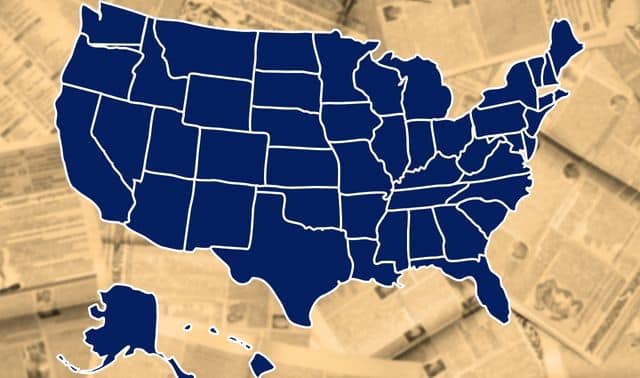Sign up for the Family Tree Newsletter! Plus, you’ll receive our 10 Essential Genealogy Research Forms PDF as a special thank you.
Get Your Free Genealogy Forms
"*" indicates required fields
Newspapers give you a glimpse of your ancestors’ lives as they unfolded. In the February 2007 Family Tree Magazine, we offer strategies for researching historical newspapers, even if they’re not indexed. Here, you’ll find more details from immigration-records expert John Philip Colletta about the port news sections of historical papers, as well as additional resources for your newspaper research.
As the SS Veendam entered New York Harbor on Aug. 30, 1892, Franz Schnell waited breathlessly in steerage with his wife and nine children. Ten days before, the family had boarded in Rotterdam, Holland, bidding farewell to their native Russia. Now, finally, they were passing through the gate to their future: America!
But when the cabin-class passengers had stepped onto the pier in lower Manhattan, the Veendam veered away, steamed into a detention dock of Staten Island and raised a yellow flag. Cholera had broken out in Russia and spread to other ports. The day before, 22 steerage passengers from Bremen had arrived in New York City dead. The Schnell family would have to wait—the Veendam was in quarantine.
ADVERTISEMENT
Detailed New York Times articles described the process: The steerage passengers were stuck on board until finally, on Sept. 1, they were transported to the Quarantine Hospital on Hoffman Island, just outside the Verrazano Narrows. There, they stripped and bathed, while their clothing and baggage were sent through a disinfecting steam shower. Then, returned to the Veendam, they waited again: Would the cholera show itself?
Similarly, newspapers of your immigrant ancestors’ ports of entry provide vivid details about their experiences. Port-city newspapers in the 19th and early 20th centuries regularly carried articles titled Harbor News, Marine Intelligence or Port Items. Though the content varied from port to port and era to era, such columns generally showed:
- For every ship, the name, type, registry, tonnage and captain’s name
- For departing vessels, the port of destination
- For arriving vessels, the port of origin, intermediate ports of call, names of cabin passengers (first and second class), number of steerage (third class) passengers, names of firms receiving merchandise, and the sea and weather conditions of the voyage.
Often, unusual circumstances—in the case of the Veendam, the detention in quarantine—warranted a lengthier article in a separate column.
ADVERTISEMENT
Before you can access the right newspaper, however, you must learn the name of your ancestor’s ship, as well as its date and port of entry. Passenger arrival records revealed the Schnell family landed in New York on the Veendam in early September 1892.
Find US passenger arrival records from 1820 through the 1950s on microfilm at the National Archives and its regional facilities, the Family History Library and its Family History Centers worldwide, and many large public libraries. Portions of this enormous body of federal records have been published in multivolume sets you can consult at your library. Some records are available online—notably, passenger arrival records for the busy Port of New York, found at CastleGarden.org and EllisIsland.org. The subscription site Ancestry.com contains virtually all available US passenger records.
A variety of indexes, finding aids and search engines can help you locate a passenger among the millions enumerated on ship manifests for US ports. To use these, you need to know your ancestor’s full original name, approximate age at arrival and approximate year of arrival. Additional facts about your ancestor’s migration (he traveled with his wife and two children, for instance) will help you identify him when other passengers with the same name of about the same age arrived at the same time. For more passenger-records advice, see the August 2004 Family Tree Magazine (sold out but available in our 10 Years of Family Tree Magazine: 2000-2009 DVD) and the National Archives Web site.
Once you’ve learned the name of your ancestor’s ship and its port and date of entry, you can get the story from the newspaper. Papers of all five major ports (Boston, New York, Philadelphia, Baltimore and New Orleans) and most minor ones (Providence, RI; Galveston, Texas, and San Francisco, to name just three) are readily available on microfilm.
The following Web sites also will help you find historical newspapers. For additional resources and how-tos on accessing old newspapers throughout the United States, see the February 2007 Family Tree Magazine:
- US Newspaper Program
www.neh.gov/projects/usnp.html
Click your ancestral state for newspaper microfilming projects and which repositories have the film. - Library of Congress Microfilm Index
lcweb.loc.gov/rr/news/oltitles.html
Links to dozens of period newspapers for more than three centuries of indexed announcements, death notices, photographs and other news items. - National Library of Canada
www.nlc-bnc.ca/8/16/index-e.html
More than 200,000 reels of newspapers on microfilm. - American Newspaper Repository Collection, 1809-2004
scriptorium.lib.duke.edu:80/dynaweb/findaids/americannewspapercol/@Generic__BookView
Duke University holds the collections of this nonprofit group founded by Nicholson Baker, author of Double Fold: Libraries and the Assault on Paper (Random House, $25.95). - US News Archives on the Web
www.ibiblio.org/slanews/internet/archives.html
Links to recent newspaper archives online. - Cyndi’s List: Newspapers
www.cyndislist.com/newspapr.htm
Find links to collections (many free) of digitized newspapers from across the country.
ADVERTISEMENT




